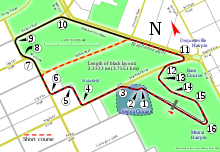1989 Australian Grand Prix
| Race details | |||
|---|---|---|---|
| Race 16 of 16 in the 1989 Formula One season | |||
 |
|||
| Date | 5 November 1989 | ||
| Official name | LIV Foster's Australian Grand Prix | ||
| Location |
Adelaide Street Circuit Adelaide, South Australia |
||
| Course | Temporary street circuit | ||
| Course length | 3.780 km (2.349 mi) | ||
| Distance | 70 laps, 264.600 km (164.43 mi) | ||
| Weather | Wet, cool | ||
| Pole position | |||
| Driver | McLaren-Honda | ||
| Time | 1:16.665 | ||
| Fastest lap | |||
| Driver |
|
Lotus-Judd | |
| Time | 1:38.480 on lap 64 | ||
| Podium | |||
| First | Williams-Renault | ||
| Second | Benetton-Ford | ||
| Third | Williams-Renault | ||
The 1989 Australian Grand Prix was a Formula One motor race held at Adelaide on 5 November 1989. It took place in wet conditions, and was stopped and restarted following a first-lap collision. Andrea de Cesaris spun at the same corner on two consecutive laps. As Formula One cars are not as fast in wet conditions as they are in the dry, the race was stopped at the two-hour mark with 70 laps being completed, 11 short of the scheduled 81 laps.
The race weekend began with the debacle surrounding the events in Japan two weeks earlier where the McLaren-Hondas of Alain Prost and Ayrton Senna had taken each other out in their battle for the race lead and the World Championship with just seven laps remaining. A post-race disqualification to Senna for cutting the chicane to return to the circuit saw Prost confirmed as a triple World Champion and Senna was far from happy with FISA and in particular its French president Jean-Marie Balestre whom he accused of rigging the championship for his fellow countryman. Senna initially threatened to boycott the event and leave Formula One altogether. However, after lengthy talks with his family and McLaren boss Ron Dennis, he reluctantly showed up at Adelaide and immediately set the pace on Friday, showing he would be just as strong as ever in 1990. Prost was determined to go out on a high note in his last Grand Prix for McLaren before joining Ferrari.
Despite Prost being declared World Champion, the championship was still under a cloud as McLaren were appealing Senna' Japanese Grand Prix disqualification. Ron Dennis explained in a press conference that McLaren appealing the DQ was in no way motivated against Prost (who was leaving the team) winning the championship, it was purely from the point of view that they believed a race win had unjustly been taken away from the team (including the prizemoney as well as sponsorship bonuses from team backers such as Marlboro). The fact that the outcome might favor Senna who was staying with the team was not a factor. This meant that if Senna won in Adelaide he could still be declared champion if his disqualification from Japan was overturned. In a hearing in Paris the week after Japan, FISA had also labeled Senna as a 'dangerous driver' (citing a number of incidents involving the 1988 World Champion) and gave him a six-month suspended sentence, a decision that was met with harsh criticism from many in the F1 paddock, including rival team bosses such as Ken Tyrrell. Most agreed the collision between the McLarens, while the culmination of the growing hostility between Prost and Senna that had been building since Imola, was nothing more than a racing incident and that Senna was being harshly punished by the governing body of the sport. Dennis also claimed that the charges and subsequent Paris hearing against Senna were farcical and that the stewards report of the incident had been "badly changed" from the initial one given in Japan.
...
Wikipedia
